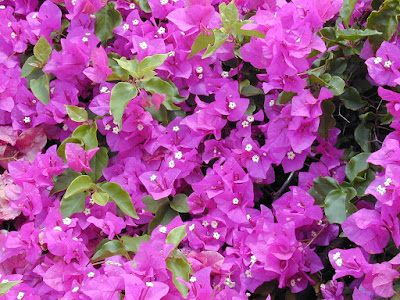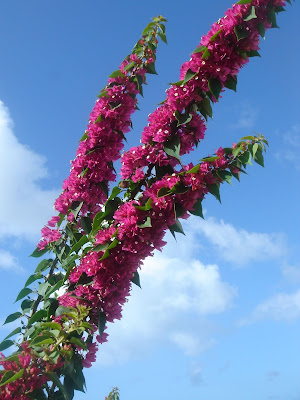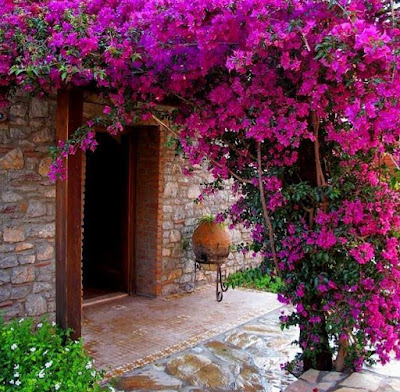Bougainvillea peruviana - Peru Bougainvillea is not as vigorous as some of the hybrids and often requires pruning to promote substantial branching.
Bougainvillea peruviana, also called as Peru Bougainvillea, Tricycla peruviana, is a species of the genus Bougainvillea. This species was described by Alexander von Humboldt and Aimé Jacques Alexandre Bonpland in 1808.
IDENTIFY BOUGAINVILLEA PERUVIANA - PERU BOUGAINVILLEA
Bougainvillea peruviana is native to Bolivia, Ecuador, Peru. It is regarded as one of the major Bouganvillea species responsible for the vast applications in urban landscaping. Due to its attractive and colorful bracts, many crosses among various species have produced new hybrid species and important cultivars, wherein hybrids such as Bougainvillea x buttiana and Bougainvillea x spectoperuviana are common Bougainvillea hybrid species derived from this species.
It is an evergreen, climbing shrub with thorny stems. This species is noted for its green bark. The long, thin leaves are strongly ovate and glabrous. The rounded bracts are magenta to pink and may have some distortion or wrinkling, and the flowers are yellow. The thorns are short and straight. The growth habit is lanky.
Peru Bougainvillea is not as vigorous as some of the hybrids and often requires pruning to promote substantial branching. The plants may bloom several times a year if subjected to dry periods between flushes.
BOUGAINVILLEA PERUVIANA - PERU BOUGAINVILLEA CARE AND CULTURE
Cultural information should only be used as a guide, and should be to be adapted to suit you. Your physical location; where you grow your plants, how much time you have to devote to their care, and many other factors, will need to be taken into account. Only then can you decide on the cultural methods that best suit you and your plants.
Light:
Bougainvillea peruviana grow best in full sun. High light intensity is required for good flowering. If grown in pot, the plants should be placed in bright light or near a window with light level of at least 4000 foot-candles. In low-light interior environments, their high light requirement leads to leaf drop. Bracts will be a lighter color than those grown in full sunshine.
For the plants grown in pot or container: "The amount of light at noon on a clear summer day is approximately 10000 foot-candles. On an overcast winter day, it may be as low as 500 foot-candles. Indoors, on a clear summer afternoon, the direct sun entering a window may be 4000-8000 foot-candles, but the level will be only about 600 foot-candles in the shade to the sides of the window. The natural light indoors on the shady side of a house may be 150-250 foot-candles, depending on the amount of window area and the presence of eaves, window blinds, or curtains."
Temperature:
Peru Bougainvillea can tolerate hot dry locations, with temperatures over 38 °C. It does well in locations with a minimum of 18 °C at night and 24-35 °C during the day.
Keep your plant in a frost-free position during the winter. It can be stored at 2-3 ºC, but be aware that the plant will tend to become deciduous and lose its leaves under 10 ºC, but will leaf up again when it gets warmer. The plants can flower well during winter in temperatures above 10 ºC so long as the light is good enough.
Substrate and growing media:
Bougainvillea peruviana grows well in rich, well drained, acidic (pH 5.5–6.0) soil. It does not thrive in soil that is constantly wet. Proper soil pH is essential because it affects the availability of mineral elements. A soil pH above 6.0 increases the possibility of micronutrient deficiencies, particularly iron. Bougainvillea is drought tolerant, salt tolerant, and wind resistant.
Plants do best in large (5-10 gallon) clay containers if grown outdoors (clay containers tend to stay drier, thus stressing the plants) or in large handing baskets. The 10" basket is the commercial standard, but plants will do much better in 12" hanging baskets. Any well drained potting medium is suitable for growing. A 1:1 peat : perlite medium is suitable. If more weight is needed to stabilize the pot, man-made sand or soil may be added. The medium needs to be well drained to prevent a poor root system and reduced flowering. Avoid media with high peat content and water-retention levels. These types of media retain too much water and will contribute to root rot.
Watering:
Peru Bougainvillea flower best under stress. Water regularly after planting to encourage a deep root system, then reduce to only as needed. Keep the plant slightly on the dry side, and allow the plant to become root bound. Wet, waterlogged soil can cause root rot and make the plants susceptible to pest problems.
Plants should be watered when the medium surface becomes dry. Close
attention is needed because it is easy for plants to use up the available
moisture in the pots. The amount of water needed depends on the medium type,
environmental conditions, size of the plant, and pot size. Watering well but
less frequently is better than frequent, light waterings.
Fertilizer:
Fertilize the plant at the time of planting and again as needed throughout the plant's life. A balanced, slow-release fertilizer containing nitrogen and iron keeps plants healthy and encourages blooming. Avoid overdoing it with nitrogen fertilizers, however; too much nitrogen can lead to large, bushy plants that produce few flowers.
In pot cultivation, an evenly balanced controlled-release fertilizer (e.g., 8-8-8 or 10-10-10) can be applied every three months. Water-soluble fertilizer formulations can be applied weekly or bi-weekly at half-strength to provide a low nutrient concentration.
Pruning:
Regular pruning is necessary to shape the plant and direct its growth because the shoots often grow vigorously. Prune after it stops blooming. Bougainvillea blooms on new growth. So once its blooming cycle ends, use a set of garden pruners to trim off one half of the new growth that ends with the flower. For example, if the plants have 4 inches of new growth at the end of a blooming cycle, you can cut off the flowers along with 2 inches of stem. This will encourage the next blooming cycle to begin more quickly.
To reduce the size of plants, cut them back by about a third, removing all spindly and twiggy growth. Prune suckers from the plant’s base to encourage top-growth. Dead wood should be removed as it appears. The long shoots can be trained in various shapes and heights - espaliers, arbors, twisted or braided trunks, or even large, fanciful animals.
Flowering:
Bougainvillea peruviana will flower sooner and more profusely with high light intensities, moderate temperatures, and longer nights. Short daylengths enhance flowering: 8– 11-hour daylengths with high light intensity and temperatures above 14-18 °C. Heavy shade inhibits flowering. Drought stress can stimulate flowering even under long daylengths. Growers frequently allow plants to dry just to the point of wilting to induce flowering. Use care, because excessive drying can cause leaf drop and dormancy.
Pruning plants too frequently will inhibit flowering. Too much fertilizer will add growth but inhibit blooming. Nitrogen and phosphate are critical to flowering, but do not overfertilize. Keep soil moisture on the dry side.
Pests and diseases:
No pests or diseases are of major concern but occasionally leaf-chewing worms or aphids. Aphids suck the sap, causing speckles on the foliage, reduced color, stunting, wilting, and deformed leaves. In severe cases, leaf loss occurs. In this case, insecticidal soap is the safest and most effective control strategy. Controlling the ants will go a long way in helping to control aphids, as well as scales and mealybugs. Ants move these insects around and harvest the honeydew they exude. Ants also protect these insects from predators and parasites.
If the leaves are eaten, severe scalloping of leaves, its can cause of Bougainvillea loopers. As the population multiplies, plants can be defoliated. In this case, use Bacillus thuringiensis (BT) insecticide; neem-based biological insecticide products; most synthetic insecticides with labels permitting use against caterpillars on land-scape ornamentals, organic insecticide Spinosad. Spraying late in the evening, when caterpillars and adult moths are active, is recommended.
Propagation:
Peru Bougainvillea are usually propagated by cuttings. They grow readily from cuttings 4"-6" long, and in 4-6 weeks will develop good root systems when given bottom heat and mist. When well rooted in perlite/peat moss mix, they can be potted in small containers in a soilless mix with added perlite to give more drainage. Care should be exercised in transplanting since the fine roots often do not knit the soil together in a firm root ball.
Leaf-bud cuttings can be used when source material is limited. Each node can be used as a cutting. The cutting, taken from shoots that are partially matured, consists of a leaf blade and a short piece of the stem (1-1.5 inches) with the attached axillary bud. Cut the stem section about 0.5-1 inch above and below the point of leaf attachment. Place the bud vertically in a rooting medium and lightly cover it (1 ⁄4 inch) so that only the leaf blade can be seen.
Some cultivars that have little or no chlorophyll in their leaves are difficult to grow from cuttings and need to be grafted onto a vigorous rootstock to be propagated. Grafting is useful with delicate cultivars that have fragile root systems. It is also used when it is desired to have multiple cultivars on one plant. The scion should be free of disease. The rootstock could be a seedling or a rooted cutting of an existing, established plant. All cut surfaces should be covered with grafting wax once the join is made to prevent moisture loss. Remove shoots from the rootstock. Put the grafted plant in a humid environment so the scion does not dry out. Various kinds of grafts may be used, including wedge, whip or tongue, or approach graft.
BUY BOUGAINVILLEA PERUVIANA - PERU BOUGAINVILLEA AND RELATED PRODUCTS
BUY ANOTHERS SPECIES AND VARIETIES OF BOUGAINVILLEA GENUS HERE!

















COMMENTS